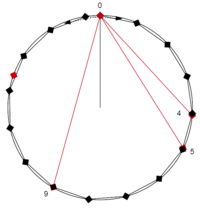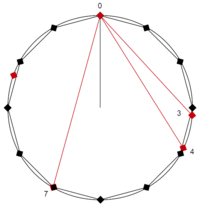
12 TET: 300 cents ,
Alpha scale: 312 cents
The α (alpha) scale is a non-octave-repeating musical scale invented by Wendy Carlos and first used on her album Beauty in the Beast (1986). It is derived from approximating just intervals using multiples of a single interval, but without requiring (as temperaments normally do) an octave (2:1). It may be approximated by dividing the perfect fifth (3:2) into nine equal steps, with frequency ratio [1] or by dividing the minor third (6:5) into four frequency ratio steps of [1][2][3]
The size of this scale step may also be precisely derived from using 9:5 (B♭, 1017.60 cents, ) to approximate the interval 3:2 / 5:4 = 6:5 (E♭, 315.64 cents, ).[4]
- Carlos' α (alpha) scale arises from ... taking a value for the scale degree so that nine of them approximate a 3:2 perfect fifth, five of them approximate a 5:4 major third, and four of them approximate a 6:5 minor third. In order to make the approximation as good as possible we minimize the mean square deviation.[4]
The formula below finds the minimum by setting the derivative of the mean square deviation with respect to the scale step size to 0 .
and ()
At 78 cents per step, this totals approximately 15.385 steps per octave, however, more accurately, the alpha scale step is 77.965 cents and there are 15.3915 steps per octave.[4][5]
Though it does not have a perfect octave, the alpha scale produces "wonderful triads," ( and ) and the beta scale has similar properties but the sevenths are more in tune.[2] However, the alpha scale has
- "excellent harmonic seventh chords ... using the [octave] inversion of 7 / 4 , i.e., 8/7 []."[1]
| interval name | size (steps) |
size (cents) |
just ratio | just (cents) |
error |
| septimal major second | 3 | 233.89 | 8:7 | 231.17 | +2.72 |
| minor third | 4 | 311.86 | 6:5 | 315.64 | −3.78 |
| major third | 5 | 389.82 | 5:4 | 386.31 | +3.51 |
| perfect fifth | 9 | 701.68 | 3:2 | 701.96 | −0.27 |
| harmonic seventh | octave−3 | 966.11 | 7:4 | 968.83 | −2.72 |
| octave | 15 | 1169.47 | 2:1 | 1200.00 | −30.53 |
| octave | 16 | 1247.44 | 2:1 | 1200.00 | +47.44 |
- ^ a b c Carlos, Wendy (1989–1996). Three asymmetric divisions of the octave (Report). Archived from the original on 2017-07-12. Retrieved 2010-06-13 – via WendyCarlos.com.
9 steps to the perfect (no kidding) fifth." The alpha scale "splits the minor third exactly in half (also into quarters).
- ^ a b Milano, Dominic (November 1986). "A many-colored jungle of exotic tunings" (PDF). Keyboard. Archived (PDF) from the original on 2010-12-02. Retrieved 2010-06-13 – via wendycarlos.com.
The idea was to split a minor third into two equal parts. Then that was divided again.
- ^ Carlos, Wendy (2000) [1986]. Beauty in the Beast (record liner notes). ESD 81552.
- ^ a b c Benson, Dave (2006). Music: A mathematical offering. Cambridge University Press. pp. 232–233. ISBN 0-521-85387-7.
This actually differs very slightly from Carlos' figure of 15.385 α-scale degrees to the octave. This is obtained by approximating the scale degree to 78.0 cents.
- ^ Sethares, W. (2004). Tuning, Timbre, Spectrum, Scale. Springer. p. 60. ISBN 1-85233-797-4.
... scale step of 78 cents.





